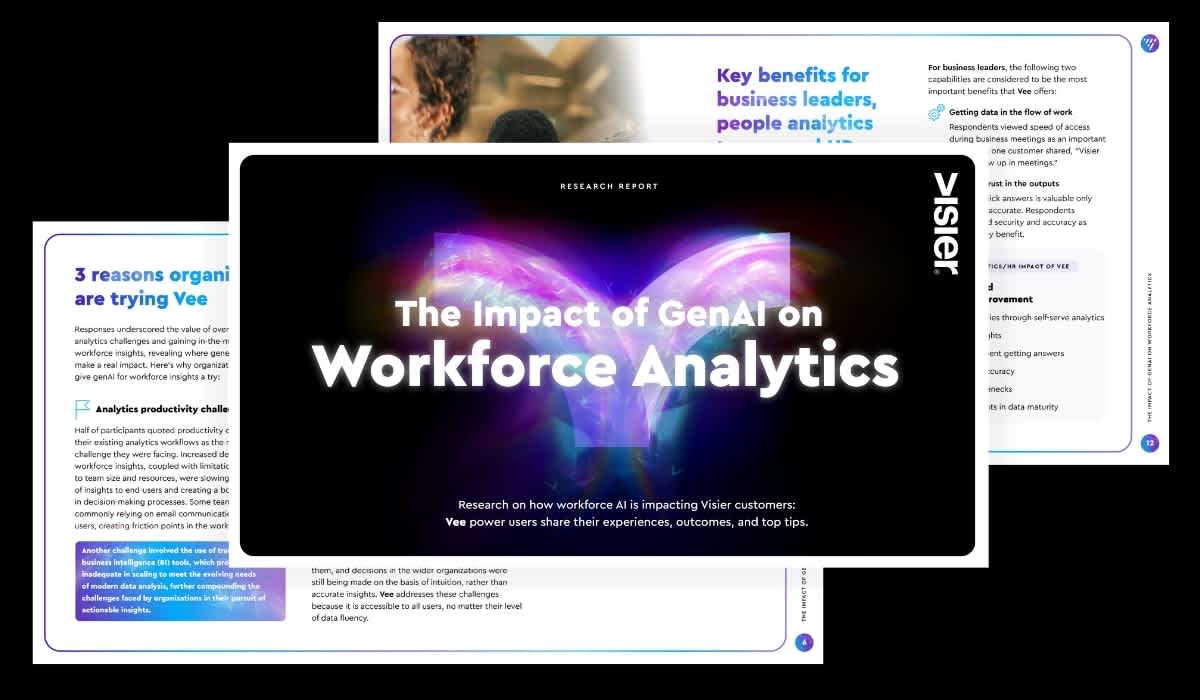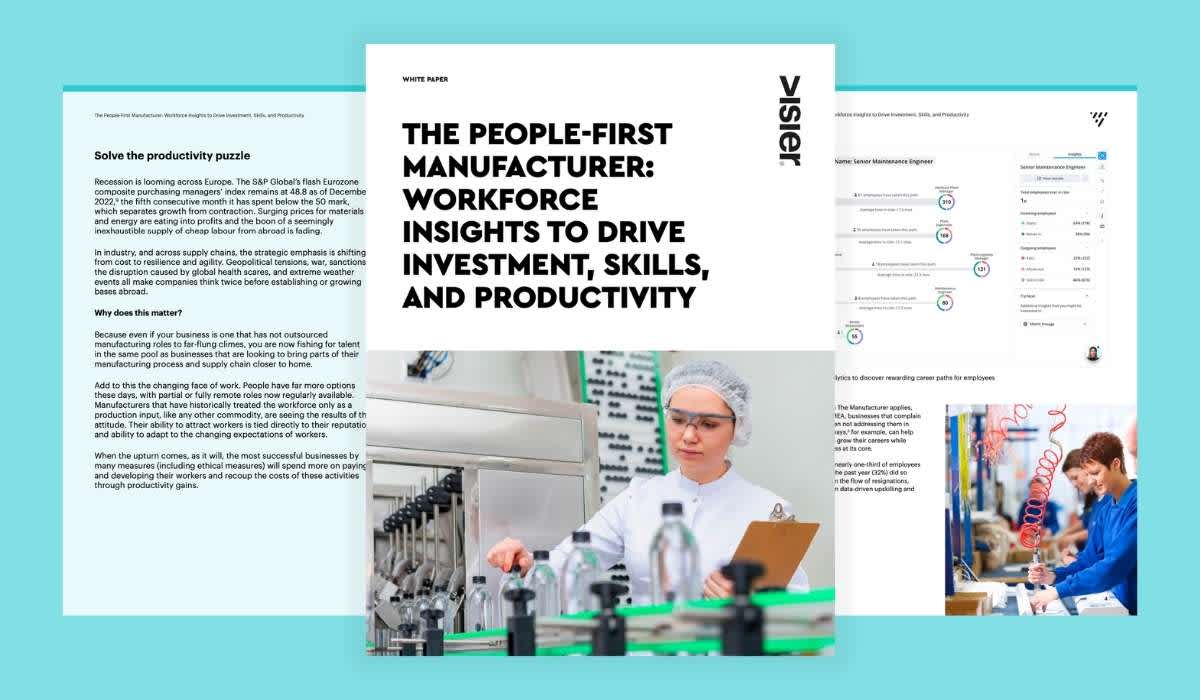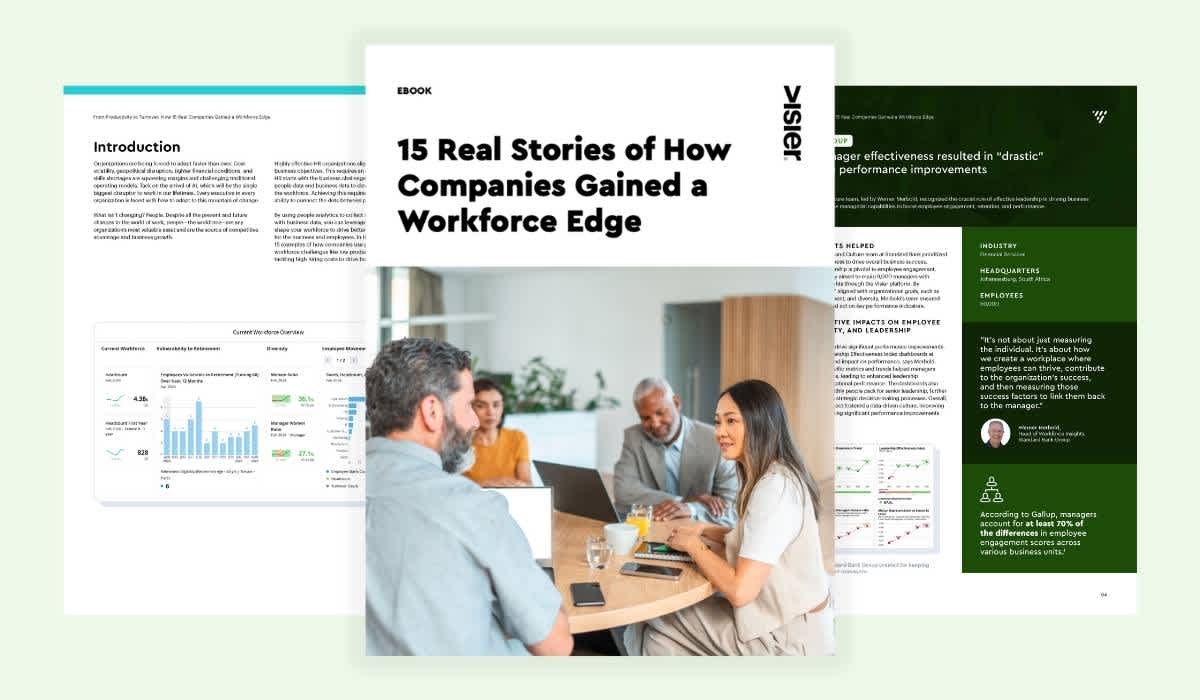Workforce Analytics Guide: Transform HR with Data-Driven Insights
Learn how to improve workforce management, planning, and business outcomes with workforce analytics.

Workforce analytics meets organizational effectiveness every step of the way. According to McKinsey research, “S&P 500 companies that excel at maximizing their return on talent generate an astonishing 300 percent more revenue per employee compared with the median firm.”
That’s a significant return on investment (ROI) and one that any company would aspire to.
The efficient use of workforce analytics can get them there.
Workforce analytics is a combination of data-informed methods and tools that aim to measure and improve workforce management and planning. Data collected from both internal and external sources is used to generate actionable information to drive informed business decisions.
This article provides a comprehensive and up-to-date guide to understanding and implementing workforce analytics for improved organizational outcomes.
There’s no reason not to use workforce analytics. Data is more prevalent, accessible, and interpretable than ever before. Tools like Visier’s Vee, a generative AI (GenAI) digital assistant, democratize data, putting it in the hands of anyone within the organization who needs data to drive better decision-making.

What is workforce analytics?
Workforce analytics is the process of accessing and synthesizing information from a variety of sources.
These help you make well-informed decisions about how to find, hire, train, engage, and deploy an organization’s human resources. The goal is to determine how workforce behavior impacts business performance.
Workforce analytics differs from HR analytics in that it’s broader, more strategic, and designed to support workforce planning. HR analytics, also known as staff statistics, demographics, or talent statistics, simply analyzes and manages employee-specific data.
Both are important.
But the effectiveness of workforce analytics, powered today by AI, the availability of real-time data, and predictive analytics can impact productivity and bottom-line related outcomes.
The evolution of workforce analytics has been remarkable. And it'll continue to have a profound impact on the workplace and how leaders make better people-related decisions.
Today’s advanced analytics capabilities mean that companies can use real-time data processing, AI and machine learning, advanced visualization, and predictive modeling to glean more sophisticated and actionable insights.
C-suite and HR leaders have the power today to analyze massive amounts of data. They do this by pulling from both internal and external sources to identify correlations, best practices, areas of opportunity for improvement, and predictions about future events.
Why is workforce analytics important today?
Companies today must balance a wide range of priorities related to managing remote and hybrid work models. They're dealing with shortages of talent for key positions, meeting changing employee expectations, rapidly evolving employee demographics and the impact of DEI, and the need to address competition from new and global organizations in physical and digital environments.
Workforce analytics helps organizations address these challenges by providing insights into both broad and specific aspects of the workforce—from talent acquisition to employee engagement, productivity, and more.
This is true for both new and evergreen human resource challenges.
For instance, workforce analytics can help remote and hybrid organizations gain visibility into how remote work is impacting performance, identify employees who may be struggling or feeling isolated, and help to optimize hybrid and remote work policies.
In a more traditional sense, workforce analytics can help you identify the best sources of talent based on offer acceptance rates, productivity, and longevity, or predict the future risk of attrition and turnover using predictive analytics.
Key applications of workforce analytics
HR metrics and workforce analytics can be used across the HR and talent cycle—from recruitment, to hiring, onboarding, training, coaching, evaluating, engaging, and managing talent to workplace planning.
In recruitment…
Modern workforce analytics has transformed the recruitment process into a strategic, data-driven process that can yield significantly better hiring outcomes.
Predictive analytics can help companies predict which candidates are most likely to succeed in their roles based on an analysis of patterns from top performers. This might include data points like educational background, previous experience, assessment scores, and even interview feedback patterns.
Workforce analytics can also play an important role in identifying where qualified diverse candidates can be found and where they might be lost during the hiring process or after onboarding.
Tracking diversity ratios at each stage of recruitment and the first year of employment, for instance, can provide insights into opportunities for targeted interventions to boost retention and engagement.
In employee relations…
What if you could predict the employees who are at the greatest risk of leaving your organization?
Well, you can! Advanced analytics capabilities provide organizations with insights into the drivers of turnover so they can take proactive action to minimize employee resignations.
Consider that, according to Deloitte, the average cost to replace employees can range from one-half to two times their annual salary. In addition, turnover can be a signal that other employees might be at risk of leaving, too. Visier research found that when a resignation occurs, employees on that team are 9.1% more likely to leave within the next 135 days than employees who aren’t on that team.
Those aren’t risks that any organization wants to take. Workplace analytics can serve as an early warning sign of potential impact, allowing HR leaders and managers to take action to keep key employees on board.
In talent management…
Workforce analytics can help with skills gap analyses, succession planning, and performance management. Companies can map current employee skills to future needs, to identify gaps and create targeted development programs. Predictive analytics can be used to identify high-potential employees and to model various succession models.
Advanced metrics can also be used to tie performance data to factors like manager effectiveness, participation in training, the distribution of workloads, and team dynamics to determine what drives high performance.
In workplace planning…
Strategic workforce planning requires an understanding of both internal dynamics and external market trends. Workforce analytics can help organizations model various business situations and the implications for the workplace.
Using “what-if” scenarios, HR and C-suite leaders can understand the specific workforce implications of different business strategies, economic conditions, or organizational changes.
To manage and improve the employee experience…
The employee experience has a marked impact on engagement, productivity, and retention. Using natural language processing (NLP) tools, organizations can analyze employee feedback obtained through surveys and other sources to identify potential pain points. Analytics can help track the employee experience to identify critical moments that impact engagement and retention.
Understanding the employee experience and how it's impacted by workload distribution, work-life balance, and other stress factors can ensure that organizations are maximizing the value of their human resource investments.
CommonSpirit Health, one of the largest health systems in the United States, used workforce analytics to address critical healthcare staffing challenges.
By implementing advanced analytics, they gained visibility into turnover patterns across their organization, identified employees at risk of leaving before they resigned, and developed targeted retention strategies.
The results were significant improvements in both employee satisfaction and patient care outcomes, demonstrating how workforce analytics can address sector-specific challenges while delivering measurable business value.
Implementing workforce analytics: a modern approach
There are a number of steps involved in implementing workforce analytics so that it’s designed to be useful, accessible, meaningful, and impactful for users and the organization.
Setting clear objectives and KPIs
Start with a clear understanding of what you want to get out of your workforce analytics efforts. Setting clear objectives and KPIs that are directly tied to business strategies and objectives will help ensure both alignment and relevance.
For example, if a key business outcome is strong customer satisfaction, using workforce analytics to understand the impact of employee engagement and turnover on customer satisfaction would clearly be useful information to have.
Your objectives should follow the SMART criteria. This means they should be specific, measurable, achievable, relevant, and time-bound. For example: “Reduce turnover in critical roles by 20% within 12 months” or “Improve diversity in leadership positions by 15% in the next 24 months.”
Suntory Global Spirits exemplifies this strategic approach. Rather than implementing analytics in isolation, they aligned their workforce analytics objectives with their global expansion strategy and talent development goals.
This alignment enabled them to use data insights to make talent decisions that directly supported their business growth across multiple regions, demonstrating the importance of connecting workforce analytics to broader organizational objectives.
Data collection and integration
You’ll be drawing data from multiple sources. Identifying and cataloguing these sources ensures quality and effective governance. Data sources include HRIS systems, performance management inputs, inputs from learning management systems (LMS), employee engagement survey data, exit interviews, and financial systems. You might also incorporate external employee and customer market data.
Data governance processes should be focused on documenting and ensuring regular data cleaning, validation processes, and quality checks.
Choosing the right technology and tools
Modern workforce analytics platforms leverage AI and machine learning to identify patterns, predict outcomes, and generate insights that would be impossible to discover through traditional analysis methods.
Workforce analytics platforms like Visier’s Workforce AI Edge offer these capabilities through an intuitive interface, with self-service capabilities and visualization tools (like dashboards and user-friendly charts/graphics). These make insights accessible and understandable to everyone, including non-technical users.
Choosing platforms that can grow with your organization and its volumes of data and analysis needs supports scalability. Cloud-based solutions also allow for flexibility and ease of access from anywhere on a 24/7/365 basis.
Analyzing data and generating insights
Today’s updated methods of data analysis, including predictive modeling, can yield actionable recommendations to drive real business outcomes. While descriptive analytics can tell you what happened, predictive analytics can give you insights into what might happen next.
Today’s workforce analytics should be designed to offer actionable insights to help answer the questions of: “So what?” and “What should we do next?”
Suntory Global Spirits provides another great example of this. Suntory used advanced workforce analytics to help minimize costs and improve staffing to keep the company competitive in a variety of markets. They consolidated data across data sources and gave executive leadership clear, actionable insights based on critical metrics like headcount, open roles, and compensation costs.
This allowed their HR teams to zero in on talent gaps, strengthen succession planning, and adjust quickly to changing market needs. Suntory was also able to make more informed talent decisions that benefit both the growth of the organization and the development of its employees.
Reporting and communication
Communicating insights to stakeholders requires the consideration of how to make patterns and trends immediately apparent through the right visualization practices, avoiding chart clutter, and focusing on the most important insights.
Clear and impactful reports shared on a regular basis leave room for discussion and feedback. This can help organizations continually improve their data collection, analysis, and reporting practices.
When reporting workforce analytics, transforming complex data into a compelling narrative can ensure that the information resonates with different audiences.
C-suite level dashboards should focus on high-level metrics and overall business impact, for instance, while operational reports can include more detailed and tactical information.
Change management
The need for change is often driven by data outputs and it’s natural to face resistance to change.
Building data literacy across the organization and fostering a data-driven culture can help employees understand the why behind business decisions and see directly how the data supports these decisions.
Making data widely accessible can help drive transparency and increase trust.
Future trends in workforce analytics
The future of workforce analytics will be increasingly predictive, allowing organizations to anticipate and address challenges and capitalize on opportunities. Real-time data and analytics ensure timely and proactive responses and decisions designed to leverage the value of data-driven insights.
The use of data will continue to focus on ethical considerations and data privacy, especially as workforce analytics becomes more sophisticated and granular.
It’s important to ensure that data protection measures are robust and to have clear policies about how employee data is used, including compliance with regulations like GDPR and continually emerging privacy laws on the federal, state, and local levels.
Ready to transform your HR strategy with data-driven insights? Contact us to learn more about how Visier's workforce analytics platform and Vee can help your organization make the most out of the workforce data you have and drive better business outcomes, no matter the platform.

Workforce analytics FAQs
What are the benefits of using workforce analytics?
Workforce analytics offers plenty of benefits, like improved employee retention, better hiring decisions, improved employee experience, more strategic workforce planning, cost reduction, and stronger business performance. Using workforce analytics effectively can also improve key metrics like turnover rates, employee engagement, and time-to-hire.
What is the difference between HR metrics and workforce analytics?
HR metrics are operational data points like turnover rate, time-to-fill, or employee satisfaction scores. Workforce analytics takes a broader, more strategic view, using advanced analytical tools to glean deeper insights into the current state and make predictions about future trends and outcomes.
How do I get started with workforce analytics?
The first step is to define clear objectives aligned with business goals and objectives. Identify the key questions you need to answer about your workforce and its impact on business strategy. Consider investing in a workforce analytics platform that can connect your data, apply advanced analytics, and provide user-friendly analysis tools.
What data do I need for workforce analytics?
There is a wide range of data (both internal and external) that can provide important insights about your workforce, including HRIS inputs, performance management scores, LMS data, the results of satisfaction and engagement surveys, turnover and retention data, and more. The data you need will be directly related to the objectives you set.
How can workforce analytics improve employee retention?
Workforce analytics tools help you identify employees who may be at risk of leaving your organization by applying predictive analytics. Predictive models can analyze patterns in employee data to flag at-risk individuals, while correlation analysis reveals which factors most strongly influence retention decisions.
Is workforce analytics only for large organizations?
No. While large organizations may have more resources to invest in sophisticated workforce analytics platforms, workforce analytics is an important tool for organizations of all sizes. Many cloud-based workforce analytics platforms are designed to scale with organizational needs.


